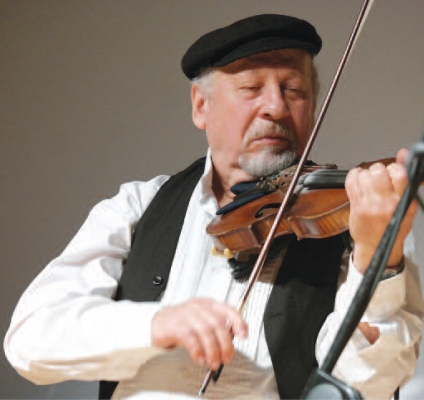Stempenyu - A Lopsided Review
"Stempenyu: A Jewish Romance" by Sholem Aleichem (Solomon Rabinowitz), Translated by Hannah Berman, 1913 (Melville House Publishing, 2008; First Published in Yiddish, 1888 by Folksbibliotek).Also in Hebrew: Dvir Publishing, Tel-Aviv, Israel, 1915 (תשכ"ח) 3rd printing ; Translated by I. D. BerkwitzOriginally written in Yiddish, Sholem Aleichem used this pen name, which means "Peace Be unto you", and is a typical Jewish greeting.
Background
Stempenyu is the amazingly funny story of a young village girl who falls for a wildly popular klezmer fiddler (a Yiddish superstar, named Stempenyu). The character, based upon an actual mid-19th century Yiddish fiddler, whose fame set off a kind of pop hysteria in the European Jewish small town shtetls, whom Sholem Aleichem knew, or knew about. Thus, the story, in this contemporaneous "authorized" translation, is a wonderful introduction to Aleichem's work as he wanted it read, including the unique palaver of a nineteenth-century Yiddish rock star.
In our story, Stempenyu, typical of klezmer musicians, comes from a long line of klezmer performers, for example his father Berel Bass was a double bass player, Stempenyu's grandfather played trumpet, and so on back, at least to his great-great grandfather who played the fiddle.
Sholem Aleichem, steps out of the tale and tells us, "This story does not have any murders, killings and tremendous emotional outbursts". This is a story about simple people whose lives are lived in ordinary ways. As the story unfolds, we have a good picture of life in the Jewish shtetl. But beyond this we have a universal story of compassion, humor, and interaction among people.
Stempenyu's description, especially in the beginning, is depicted as almost like the devil. He bewitches with the blaze of his music and finds women falling at his feet with his fiery passionate fiddling. In other ways, Stempenyu is described almost like the image of the great violinist Niccolo Paganini. In fact, as the story develops, we are told that Stempenyu's violin might have even belonged to Paganini.
The story revolves around three main characters: Stempenyu the fiddler, Rochalle the beautiful girl whom Sholem Aleichem considers the main character and around whom most of the action takes place and Freidel whose talent for business led her into anxiety about money and through chicanery married Stempenyu. All other characters are sketches to a greater or lesser degree.
Klezmer – Short History
Klezmer music has deep historical roots. Some say that it stems from the 16th century, as special Jewish music that accompanied weddings, ceremonies and other events in the cycle of Jewish life. The klezmer tradition has produced a number of great musicians, such as Mischa Elman, who came from a line of klezmerim as his grandfather was also a klezmer fiddler. Regardless, klezmer musicians generally had a very low standing in the community and were typically considered not much better than criminals. One of the reasons is that klezmers were generally itinerate performers, having few roots in any one place. Commonly not paid very well, klezmerim tended to do a bit of petty thievery.
Klezmer history is unclear, but seems to be a mixture of Baltic, Gypsy, Jewish music, as well as other types of integrated musical forms, even jazz. Most klezmer music was centered in the areas of Western Russia (especially in the Ukrainian areas between Odessa and Kiev), Romania and some of the northern Baltic areas, with many regional variations.
For a period of time in the late 1940s and 1950s, klezmer music became a quaint form of music, which was not appreciated and fell into disuse. In Jewish weddings at the time, the band might be asked to play one or two klezmer pieces. In many weddings the "modern" bride and groom would not even allow klezmer music, instead preferring rock and roll, American pop, or in rare cases some jazz or American ethnic music, but not Jewish klezmer. In Israel, the tendency was towards "Israeli folk music". Then around the 1970s a renaissance in klezmer music took place in the United States. This culminated in 1996 with Itzak Perlman's famous session called "Live In the Fiddler's House".
Well, if Perlman can play klezmer, then suddenly this type of Jewish music become legitimate. Klezmer bands are now a world-wide trend, even in Japan.
Klezmer music is a difficult art form to play. The music, although easy to listen to, is highly demanding of the musicians. Even Perlman has said that even with his great musical experience, klezmer music is very difficult, and he is not sure if he gets right[1]. And yet it is music that catches the soul. It is music that can make you laugh and weep all at the same time. Typically, a klezmer piece will start out slow and tragic sounding, enough to make you, the listener, cry. And then without realizing it, the music catches you up in a frenzy of sound, your feet cannot control themselves and you find yourself dancing away and out of control. Klezmer music, like the Jewish soul, covers a wide gamut of emotions and sometime very quickly.
Klezmer Language
One aspect of the klezmer is the special professional klezmer language, called "Klezmer-loshn" or literally "klezmer tongue" that developed among klezmer musicians. This is a language based on Yiddish, but with other languages adapted to its usage or simply made up words, but special to klezmer musicians. This secret argot, or jargon, was used only by klezmer musicians. Interestingly, Klezmer-loshn is almost identical to "ganovim-loshen" the argot of thieves. In fact, in our story of "Stempenyu" the fiddler is not considered much better than a common thief, although he is clearly not really much of a thief, perhaps a thief of love.Stempenyu uses this argot while performing at a wedding as he has an eye on a woman and asks his band assistant to find out who this beautiful woman is. But Stempenyu speaks to his assistant using klezmer-loshn, as he knows that the people at the wedding will not understand what he is talking about. It turns out that the woman is married, but this does not stop the "lady killer" Stempenyu.
Sholem Aleichem understood the impact and importance that music played on the daily life of Jewish people; he even tells us this in the first chapter. Stempenyu was a very well-respected musician, as people would travel far to attend a wedding at which he was playing. Sholem Aleichem says at the very beginning of the story, "From time immemorial, we Jews have loved music, and have understood what it really is. Even our worst enemies could not deny this." But he goes on to say that the music must be sad by preference and we like to weep and cry and hear the music in a minor key and feel depressed and ". . . every single one of us is plunged into the profoundest melancholy."
Jewish Life and Music in the Shtetl
To set the novella's mood and background, Sholem Aleichem devotes nearly two whole chapters at the beginning of the novella to Stempenyu as a musician. He also presents an interesting narrative about the significance of music in the Jewish cultural life during the mid to late 19th century, but presents it in a way that is at the same time humorous and most profound.
Jewish life in the shtetls was difficult. Most people were poor, but the community spirit generally, but not always, transcended personal wealth. Much social awareness depended upon the specific community. But a major form of release from this poverty was music and music crossed the boundary between rich and poor; educated and non-educated, young and old. In spite of this, klezmer standing in the community was low. Hence marrying a klezmer, if your family was not part of the klezmer tradition, would be considered a serious cultural deviation. So, it might be possible that since klezmer musicians usually belonged to a long line of musicians, who tended to intermarry within the klezmer sub-culture, that some kind of genetic reinforcement took place, in which a musical gene become dominate. An interesting question that I am not qualified to explore.
As an aside, Marc Chagall's paintings of "Fiddler on the Roof", and his fiddler drawings have nothing to do with the Sholem Aleichem's story of "Tovye's Daughter", made into the musical"Fiddler on the Roof". Chagall probably took his inspiration for his drawings from the "Stempenyu" story. Sholem Aleichem used musical motifs in many of his stories, another indication of how important music was in shtetl life.
Conclusion
Although a fairly simple story "Stempenyu" speaks to us through a universal language. We develop a feeling for the people involved, especially the three main characters. But the daily life that revolves around the "leading lady", Rochella gives us not only an interesting and hilariously funny insight into the lives of ordinary people but also gives us an insight into ourselves. What do I mean, by this? We can view ourselves through the various characters and situations in this novella and by how we react to "normal" occurrences. Life is never a straight line; that would be boring. But things happen to us and we react. Following the characters in this story can give us insights into how we ourselves react and develop over time.
As the story comes to an end and as our personal life changes and develops, do we find ourselves in a prison of our own actions as does Stempenyu? At the end of this penetrating novella, we must ask ourselves if we have created our own walls of isolation.









Comments